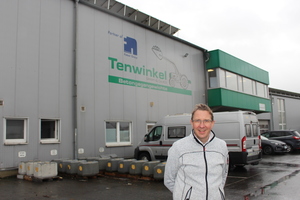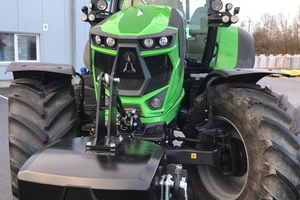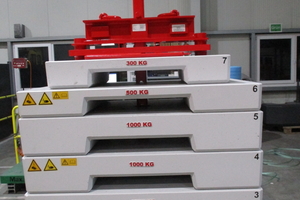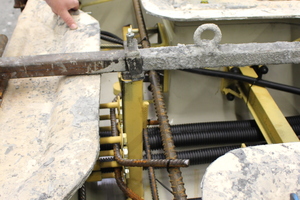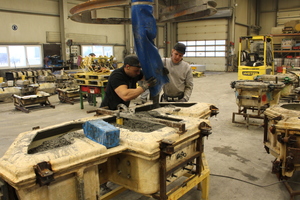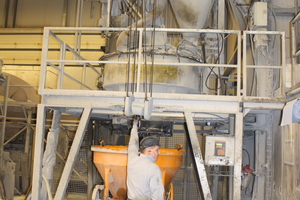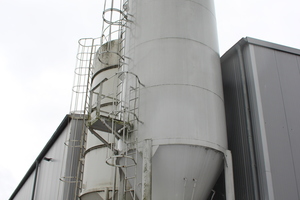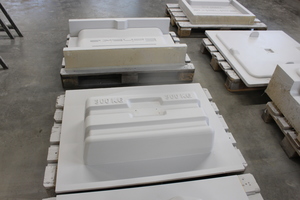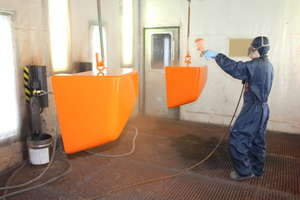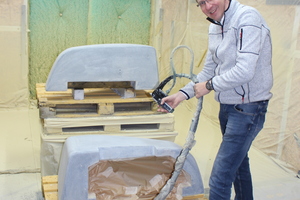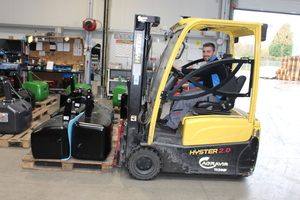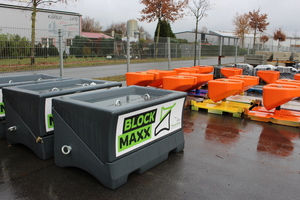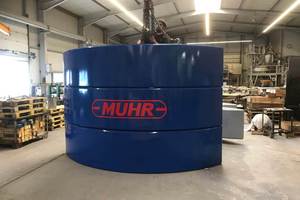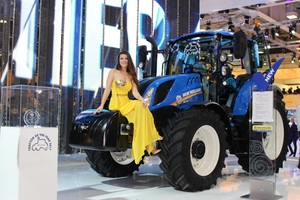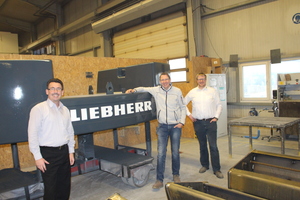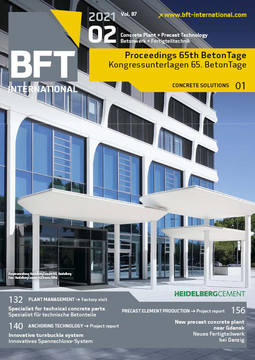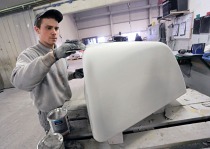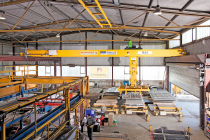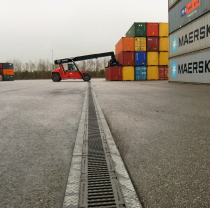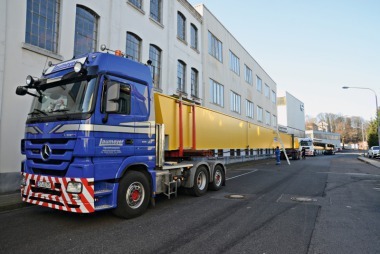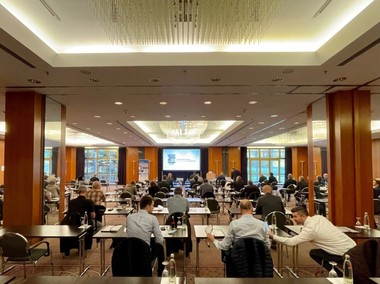Specialist for technical concrete parts since 1959 on the growth track
A good 60 years after the foundation of the company, Markus and Stefan Tenwinkel are in charge of an up-and-coming medium-sized business that sees itself as a specialist for technical concrete components. In the concrete-counterweights segment for tractors, Tenwinkel GmbH & Co. KG’s main product, the company is even world market leader.
It began in the year of 1959: in Vreden-Lünten, in North Rhine-Westphalia in Germany, the 17-year-old Heinrich Tenwinkel produced manually, for a neighbor the first concrete counterweight by hand. This one-off was cast in a hole in the ground – lined with paper – and the concrete was produced with a manual drum mixer.
Today, more than 60 years later, Markus and Stefan Tenwinkel, the sons of the founder of the company, are heading an up-and-coming medium-sized business that sees itself as a specialist for technical concrete components that are not considered as classic construction products. In the concrete counterweights for tractors segment, the main product of Tenwinkel GmbH & Co. KG, the company, with its Heavy-Concrete Competence Center is world market leader and delivers its products to a highly diverse customer base, i.e., both to family companies in the immediate neighborhood and large agricultural groups throughout Germany as well as overseas.
On the company grounds covering 16,000 square meters and located within sight of the Dutch border, a workforce of 55 and five trainees work in production. In addition to the tractor ballast weights, the portfolio includes crane test weights, crane foundations, technical concrete components for machine construction, ballast weights for construction machines and train construction – as well as special parts such as the recently developed Block-Maxx terror protection elements.
Market leader in concrete counterweights
Dipl.-Ing. Stefan Tenwinkel explained the company development as follows: “My father quickly discovered that molds – initially of wood, then of sheet steel – were the better choice, instead of continuing the old work on the ground. For many years, up until the mid-1980s, normal company business was a sideline for rear weights for tractors, but with the increasing advance of agricultural technology, the business of front weights for front hydraulics became more and more of a revenue driver. Beginning in 1995, we manufactured in an old wooden shoe factory (Ammeloe-9) outside Vreden and, since 1996, we also have a distribution partner with whom the product is marketed throughout Europe. Concrete production takes place with a Fliegl compulsory mixer on a forklift. Until 2008, production continued under relatively simple conditions, and the first full-time employee was hired at the end of 2006.”
His brother Markus Tenwinkel, who also has a master’s degree in engineering, adds: “Tractor counterweights account for approx. 60 % of turnover, followed by counterweights for construction machines at approx. 20 % and products for machine construction and miscellaneous also for approx. 20 %.”
The company really went up and running after moving, in 2008, to a new production site on Max-Planck Street. That included a new mixing plant, taking up magnetite for heavy-weight concrete production for the aggregate and our own continuous-passage painting plant, put into operation in 2015 in an additional newbuild.
“We see our strengths in the technical competence for heavy-weight concrete with high densities of up to approx. 5.5 g/cm³, in mechanical-engineering knowhow, specialized welding to DIN 3834, DIN 15085 rail products, painting expertise for work directly onto concrete and impact-protection coatings with polyurea. And, not to forget, our own mold building in metal, wood and GRC.”
In answer to the question for more details about heavy-weight concrete and thick coating, Markus Tenwinkel said: “In contrast to using heavy-weight concrete for radiation protection, we are focusing on providing cost-efficient, compact ballastering. We have therefore concentrated on the ideal density for heavy-weight concrete. For our products and applications, we have developed a formula for producing a heavy-weight concrete with a density of approx. 4.1 kg/dm³. We produce a concrete-homogeneous mass without the addition of scrap. In series production, the center of gravity of the weight therefore lies at the calculated point. With the addition of steel scrap, higher densities can be achieved.
“In order to protect our weights made of firm heavy-weight concrete with additional bumping and impact protection on exposed parts, we developed a thick coating for which we have applied a patent. This coating prevents breakout of material in the event of impact. This coating is applied to the ballastering in a separate process. The system enables application of different surface textures and can be painted in nearly every conceivable color shade.”
Extensive modernization of production
As mentioned above, the modernization offensive on a larger scale began in 2008 with installation of a Kniele cone mixer. Preliminary planning for the new mixing plant had taken 1.5 years and the cost ran to approx. 400,000 euros. This 0.5 m³ mixer, used for production of normal- and heavy-weight concrete as well as SCC, is also suitable for mixing small batches and operates with microwave water control and with consistency measurement per ampere meter.
In addition, following a two-year lead time and consultation by the plant engineering company AB Anlagenplanung, Achim, in 2015 a Rippert painting plant was installed. Including the cost for the required extension of the hall, the investment sum for this amounted to approx. 2,600,000 euros. This plant enabled painting 120 parts per shift and included a drying oven and overhead rail transport with 3-ton capacity.
Crane test weights of interest to precasters
In accordance with Principle 309-001 of the German Accident Insurance (DGUV), all operators of crane systems, also including precasters, must regularly test these systems. For this purpose, Tenwinkel offers a system protected as utility model.
The system consists of different slabs into which four each threaded inserts have been cast for secure lifting. Two short and two long socket pins hold the test slabs in place during lifting. A lifting beam with two safety attachment points distributes the lifting forces via a 2- or 4-legged chain to the crane hook. The test slabs are connected to the bolts and the lifting beam via two square pipes. The test slabs are simply stacked on top of each other by forklift or crane. Cones, integrated in the slabs, center each other. All metal parts are primed and painted in bright red (RAL 3020), and all concrete slabs are executed in the color shade light gray (RAL 7035). The weights have a tolerance of -0/+2.5 % and are cast with scales, but cannot be calibrated. .
This test-weight system can test cranes from 1,000 to 15,000 kg with 10 % overload. On request, test weights can be adjusted to the specific requirements of a customer: e.g., when stacking capacity is restricted, for limited external dimensions of the access points or for test systems above 16.5 tons (individual weights of up to 30 tons can currently be implemented). Assembled systems are tested for manufacturability. A desired individual design can also be adjusted with customized mold and paint.
Innovative company strong in research
The two still young managing directors owe the success of their company not least to their openness to new developments. Markus Tenwinkel, for example, has regularly attended IFF conferences in Weimar and intensively cooperates with their organizer, the Institute for Applied Construction Research (IAB).
The latest joint project is the development of the mobile Block-Maxx vehicle access barrier (mentioned above), which prevents unauthorized access of motor vehicles of various dimensions: i.e., which can also be used for countering terrorist attacks. The new vehicle access barrier was designed to meet the esthetic demands of visitors and organizers. It is also intended to be as inconspicuous as possible, in order not to disturb the appearance of urban areas. For a detailed report, also see BFT 11/2020 pp. 52 ff. A separate report will cover the results of live crash tests conducted recently at the CTS facilities in Münster, Germany: details that were not yet available before copy deadline.
Future development of the company
According to company management, turnover has quintupled in the past 10 years. In addition, continuous development of the brand Tenwinkel GmbH & Co. KG and its competences has taken place: heavy-weight concrete, concrete painting and coating technology, welding and metal engineering, mold building in metal and plastics engineering.
More investments are being planned for further development and marketing of in-house products, including crane test weights and the Block-Maxx terror protection element and possible development of a cooperation for these products.
The market situation is gratifying, even in corona times. There generally exists very good demand for both standard and series products. Business with crane test weights developing very well and there are always interesting inquiries for technical concrete components. New products include shielding systems in which heavy concrete offers its benefits.
In general, the company intends to continue to grow over the medium and long term: for example, by extending its capacities and additional real property acquisition.
UNTERNEHMENSHISTORIE:
1959 Gründung der Firma Tenwinkel Betongegengewichte durch Heinrich Tenwinkel in Vreden-Lünten (Westf.).
Auf dem elterlichen Hof hat er die ersten Heckgewichte entwickelt und produziert.
1985 Entwicklung und Produktion des ersten Frontgewichtes
1990 Kontakt zur Same Vertriebsgesellschaft GmbH in Groß Gerau
1996 Umzug vom elterlichen Hof des Firmengründers in die Produktionsstätte Vreden-Ammeloe 9 (Westf.).
1997 Der erste Kontakt mit dem Vertriebspartner Frans Pateer BV (Niederlande)
2004 Übernahme des Unternehmens durch die Söhne Markus und Stefan Tenwinkel und Umfirmierung zur
Tenwinkel GmbH & Co. KG
2006 Plötzlicher Tod des Unternehmensgründers Heinrich Tenwinkel
2007 Neubau einer Produktionshalle im Industriegebiet Vreden-Gaxel (Westf.)
2008 Umzug in die neue Produktionsstätte; Tag der offenen Tür; Einweihung der neuen Produktionshalle; Entwicklung und Produktion von technischen Ballastierungen und Betonformteilen
2009 Das Unternehmens-Leitbild wurde entwickelt und mit der 50-Jahre-Feier eingeführt
2010 DIN EN ISO 9001:2008 Zertifizierung erfolgreich erhalten; Mitgliedschaft im Netzwerk-Westmünsterland
2011 Serienfreigabe für Walzenzug und Gummiradwalze
2012 Erweiterung des Außengeländes auf 11.000 m²
2013 BG Zertifikat „Sicher mit System“ erfolgreich erhalten; Serienfreigabe für Straßenfertiger
2014 Erweiterung des Außengeländes auf nunmehr 16.000 m²; Erweiterung der Produktionsfläche auf 4.600 m²;
Serienfreigabe für Teleskoplader; der erste Auszubildende im Bereich Oberflächentechnik hat begonnen
2015 Inbetriebnahme der neuen Lackieranlage; Tag der offenen Tür und Einweihung der neuen Produktionshalle;
Entwicklung einer neuen Stoß-Schutzbeschichtung, zum Patent angemeldet
2016 Prototyp für Autokran produziert; erste Auszubildende zur Kauffrau im Groß und Außenhandel; Finalist beim besser lackieren Award 2016; Sieger „besser lackieren Award 2016“ in der Kategorie Inhouse Lackierung < 50 Mitarbeiter
2017 Prototyp für einen Flughafenschlepper produziert; Finalist beim besser lackieren Award2017; Sieger „besser lackieren Award 2017“ in der Kategorie Inhouse Lackierung <50 Mitarbeiter; Serienstart Liebherr LRT Allterrain- kran Gewicht 8-14 t.
2018 Schweißzertifizierung nach EN ISO 3834-2 erfolgreich erhalten
2019 BG Zertifikat „Sicher mit System“ erfolgreich erneuert; Schweißzertifizierung nach EN ISO 15085-2 erfolgreich erhalten; Erstmalig auf der BAUMA 2019 in München ausgestellt
2020 Neuzertifizierung nach DIN-ISO 2001-2015

